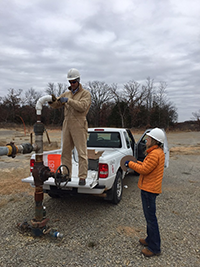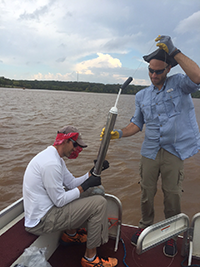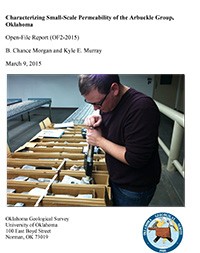Kroll, K. A., Cochran, E. S., and Murray, K. E., 2017-accepted, Poroelastic properties of the Arbuckle Group in Oklahoma derived from well fluid level response to the 3 September 2016 Mw5.8 Pawnee and 7 November 2016 Mw5.0 Cushing Earthquakes: Seismological Research Letters, p. 22.
Walker, E., Anderson, A., Read, L., Hogue, T. (2017). “Water Use for Hydraulic Fracturing of Oil and Gas in the South Platte River Basin, CO”. Journal of the American Water Resources Association. (in preparation)
Haffener, J., X. Chen, K. Murray, and T. Goebel. 2016. A robust, statistical identification and analysis of fluid disposal wells that cause earthquakes in central Oklahoma. In American Geophysical Union (AGU) Annual Fall Meeting. San Francisco, CA.Murray, K.E. 2016. Modeling Approach for Estimating Co-Produced Water Volumes and Saltwater Disposal Volumes in Oklahoma. In American Geophysical Union (AGU) Annual Fall Meeting. San Francisco, CA.
Murray, K.E. 2016. Seismic Moment versus Water: A Study of Market Forces and Regulatory Actions. GSA Abstracts with Programs 48 no. 7: 95-11. http://dx.doi.org/10.1130/abs/2016AM-286149
Perilla, P., and K.E. Murray. 2016. Pressure Prediction between Two Wells using the Laplacian Component in the Diffusion Equation: Analytical Solution in One Dimension. GSA Abstracts with Programs 48 no. 7: 120-10. http://dx.doi.org/10.1130/abs/2016AM-284106
Williams, J., and K.E. Murray. 2016. Formation Level Characterization of the Arbuckle Group in Central Oklahoma: A Key to Understanding Induced Seismicity. GSA Abstracts with Programs 48 no. 7: 309-8. http://dx.doi.org/10.1130/abs/2016AM-286782
Morgan, B. C., and Murray, K. E. (2015) Characterizing Small-Scale Permeability of the Arbuckle Group, Oklahoma. Oklahoma Geological Survey Open File Report (OF2-2015). Norman, OK. 12 pages. (PDF)




